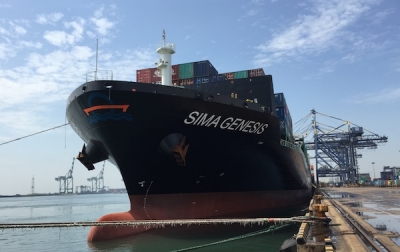Simatech leads in Gulf feedering

Dubai’s Simatech Shipping claims to be the largest feedering player in the Gulf and is continuing to grow despite concerns over the impact of the low oil price on volumes.
“I can say we are leading the market. I would say we have around 30% market share in Jebel Ali, if not more,” Simatech md CF George, told Seatrade Maritime News in an exclusive interview.
George estimates fleet capacity utilisation at between 80-90%. “We always have a policy to keep extra tonnage available, so that we don’t need to say no to customers.”
He fears that volumes and rates will go down this year as low oil prices hit the market. “Major projects could be delayed or suspended. Nobody whom I have met recently has made any positive remarks on what is going to happen in 2016, [but] everybody is hoping Iran opens up.”
During 2015, George said Simatech handled 1.63m teu at Jebel Ali, growth of 11% compared to 2014.
“We operate 54 ships along with our partners in various services. Of those, 15 are owned. We are looking to acquire more ships to replace chartered tonnage,” he said.
Recently two 4,350 teu newbuilds, the Sima Genesis and Sima Giselle, were added to the fleet.
Now 27 years old, Simatech is headquartered in Dubai’s Business Bay and has two main regional offices in Mumbai and Singapore.
“Now the ideal feeder vessel is the maximum possible. We are operating vessels sizes ranging from 200 teu to 5,000-plus teu. The business has changed. Unit cost and service efficiencies are the key.”
Simatech operates long-haul feeder services from China and Korea to India and Southeast Asia to the Gulf. It calls all the ports in the Gulf region, although those in Kuwait and Iraq pose severe draught restrictions. It also operates three services from the Indian subcontinent to the Gulf.
It recently started a service connecting Jebel Ali to west- and east-coast India. The latest vehicle is Simatech’s Indian company, Sima Marine India Pvt Ltd, a coastal service with Indian-flagged vessels.
Simatech is operating into eastern Saudi Arabia. “They have a second terminal at Dammam now. The reason for Dammam’s better performance compared to Bahrain is the domestic cargo,” he said.
“We are using the Hutchison terminal, IPS, in Dammam. The PSA terminal is just settling down, with software and customs. There is no doubt about the performance they can achieve with PSA’s backing. We are all hoping that terminal competition will bring benefits in Dammam.”
George said Somalia was a growing market, with political stability improving. “The piracy issue [has gone away] though we still maintain security guards on-board our ships,” he said.
“We recently signed an agreement with the Somali government to develop an off-dock yard outside the terminal for cold storage and general cargo storage. There is an increase in volume and we expect these to increase further once the highway to Ethiopia is open. Somali ports can become the gateway for East Africa.”
Geographical positioning and port infrastructure were key. He does not see Jebel Ali’s primacy being challenged in the next two decades. “They have a unique combination of local and transhipment cargo. Nobody can beat this combination.”
HEADLINES
- Do shipping markets want Biden or Trump for the win?
- All 18 crew safe after fire on Japanese-owned tanker off Singapore
- Singapore launching $44m co-investment initiative for maritime tech start-ups
- Cosco debuts Global Shipping Industry Chain Cooperation Initiative
- US warns of more shipping sanctions
- China continues seaport consolidation as Dalian offer goes unconditional